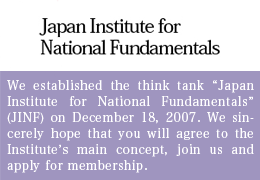New Technology Will Dispel Former Premier’s Nuclear Worries
“Japan should immediately adopt a zero nuclear policy…The existing nuclear fuel recycling project must now be discarded!”
So declared former Prime Minister Shinichiro Koizumi on November 12th before a packed audience at the Nippon Press Club in Tokyo. Mr. Koizumi claimed he is opposed to nuclear power generation in Japan because the government has failed to secure final disposal sites for radioactive wastes. But is his contention justifiable? Let us review how other nuclear nations handle radioactive waste.
Radioactive waste, including spent nuclear fuel, comes in three categories— low-level, medium level, and high-level. There is a repository for low-level wastes in Aomori Prefecture on the northern tip of Honshu. As regards high-level waste, two research institutions have been completed, one each in Gifu Prefecture and Hokkaido, probing how waste would affect concrete containers buried underground.
It is true that the government has yet to secure a final disposal site for high-level radioactive waste, as the former prime minister pointed out. But the same thing can be said about most of the world’s nuclear nations—except for the countries of Scandinavia, which have clearly designated final disposal sites.
Isn’t this situation due to the international community earnestly grappling with the question of whether burying radioactive waste deep underground—in light of rigid opposition from residents—is truly the wisest thing to do, given that it would take 100,000 years for the radioactivity level to return to a normal, i.e., natural, level? Behind such thinking is high technology being developed to reduce radioactivity to a natural level much sooner.
For instance, when radioactive waste is burned inside a plutonium-thermal type of nuclear reactor, it will take only 8,000 years to return to a natural radiation level. If this waste is burned in a next generation fast-breeder reactor, the span is said to be shortened to 300 years, the volume of high-level waste shrunk to one seventh.
Japan’s fast-breeder reactor is named “Monju.” It unfortunately has an image synonymous with problems. However, the reality is that nations boasting advanced nuclear power generation technology are once again beginning to look to fast-breeder power generation.
Advances in Science
Look at the US, for instance. In the wake of a decision by the Carter administration (1977-1981), the US was compelled to stop operation of its experimental fast-breeder reactor. However, committed to sustaining its nuclear technology and measures for radioactive waste disposal, the US is once again turning to fast-breeder technology.
France, which suspended operation of its demonstration fast-breeder reactor “Superphoenix” in 1998, is no exception, as it is once again preparing to recommission a demonstration fast-breeder reactor in 2025. The reason: France must also cope with radioactive waste.
Russia, China, and India are even more aggressively preparing for commercial utilization of fast-breeder reactors within the next 25 to 30 years.
To tell the truth, I previously had a negative view about the usefulness of the fast-breeder reactor. In the 1990s, nations such as the US and France suspended the operations of fast-breeder reactors one after another, while in Japan “Monju” caused a major fire, which forced its shutdown following a sodium leak. Now, however, new technology is known to be able to shorten the span in which high radiation levels can be brought down to normal—from 100,000 to 300 years. Science advances constantly. There is a possibility that the question of 100,000 years, which obviously concerns Mr. Koizumi most, can significantly be resolved in due time.
Next, let us consider the question of technology available to process radioactive waste. A commercial utilization of a plutonium-thermal reactor must first solve the problem of radioactive waste disposal. There basically are two ways to handle radioactive waste involved in an effective use of a plutonium-thermal reactor: ① keeping waste in glassified form, and ② keeping waste in a container called a “cask.” In point of fact, technology involving glassification as well as the use of a cask has already been solidly established in the world, with Japan having benefited from that technology for many years. For instance, spent nuclear fuel from Japanese nuclear power stations is reprocessed in countries such as France into solidified glass bodies. In this form, the spent fuel is subsequently sent back to Japan to be kept air-cooled at a storage facility in Aomori Prefecture.
While relying mostly on France, Japan has built its own reprocessing plant in Rokkasho Village in Aomori aimed at securing waste-glassification technology in an effort to independently process domestic radioactive waste. At this plant, high-level waste is evenly melted in a “smelter”—a device that electrically liquefies glass—after separating plutonium and uranium, then poured into a stainless steel receptacle called a “canister” to become vitrified again. France attained this technology several decades ago, successfully putting it to commercial use. Japan belatedly perfected it last August.
Why did it take Japan so long to accomplish what France managed to do so long ago? Here lies the crucial problem Japan faces pertaining to its nuclear power generation—inflexible government policies.
As mentioned earlier, plutonium is extracted to be transformed at a reprocessing plant into a re-burnable substance. This process generates a significant quantity of rare metal called platinoids (“cousins” of platinum, of sorts). Explains Professor Tadashi Narabayashi of Hokkaido University:
“The problem is that undissolved residues, such as platinoids, are deposited on the inner walls of the smelter. When applying an electrical current to the platinum film thus formed, electricity by-passes the glass substance. This was the biggest problem that prevented the glassification of reprocessed nuclear fuel.”
In France, they resolved this problem by making a settling tank before processing the radioactive waste, applying an electrical current only after allowing the platinum to settle on the walls of the tank. However, Japan allegedly omitted the settling tank due to cost-cutting. Professor Narabayashi continues:
Needed: Rational and Scientific Discussions
“Initially, the business plan for the processing plant was submitted—and sanctioned by the government—without including costs for a settling tank. Later, it dawned on the proprietors that they needed the tank, so a revised business plan was submitted. Both the communities around the plant, as well as the government itself, rejected it, demanding that the original plan be adhered to. That is why Japanese technicians had to work so hard for such a long time to finally develop the technology to reprocess radioactive waste without separating platinoids.”
I have twice visited the reprocessing plant in Aomori on writing assignments. On my first trip, which called for an overnight stay near the plant, I remember asking the plant manager time and again why reprocessing was not working well.
The answer I got was typically optimistic—“Science is ever-progressing, and difficult problems will eventually be overcome”—as one would expect from someone who had great dreams about the future of science. Nobody in the plant, including managers, referred to the inflexibility of Japan’s nuclear power administration pointed out by Prof. Narabayashi.
I still wonder why the people at the plant failed to mention anything about the settling tank at the time. Perhaps the atmosphere was not right for anyone there to discuss the matter in view of the tough public opinion against the government’s nuclear power administration. At any rate, every time glassification experiments failed at the plant, the results were unduly played up by the mass media, creating a popular impression that the reprocessing plant would never function properly. I was among those who felt that way at the time—something which I now deeply regret.
Problems that may be resolved rather easily if flexibility is allowed, may become insurmountable walls in the face of rigid official policies. That is why rational and scientific discussions are badly needed today in determining the nation’s nuclear future.
Sadly, Koizumi’s remarks stand out as an example of a sheer absence of rational and scientific thinking pertaining to nuclear power generation. Unable to come to grips with the latest pertinent science, he is simply backpedaling on the issue. Technologies for reprocessing radioactive waste are clearly making headway steadily. As a result, isn’t it likely that the assertion that there is “no place to deposit waste” will most likely have to be modified? I think it is highly possible that what we call “waste” today will have many uses in the future. For instance, platinoids could very well be used as a catalyst for fuel cell cars. Japan must get away from the old way of thinking and, instead, strive to fulfill hitherto impossible dreams. Isn’t it possible that this lethal waste might one day even be transformed into coveted rare metals?
(Translated from “Renaissance Japan” column no. 584 in the November 28, 2013 issue of The Weekly Shincho)








